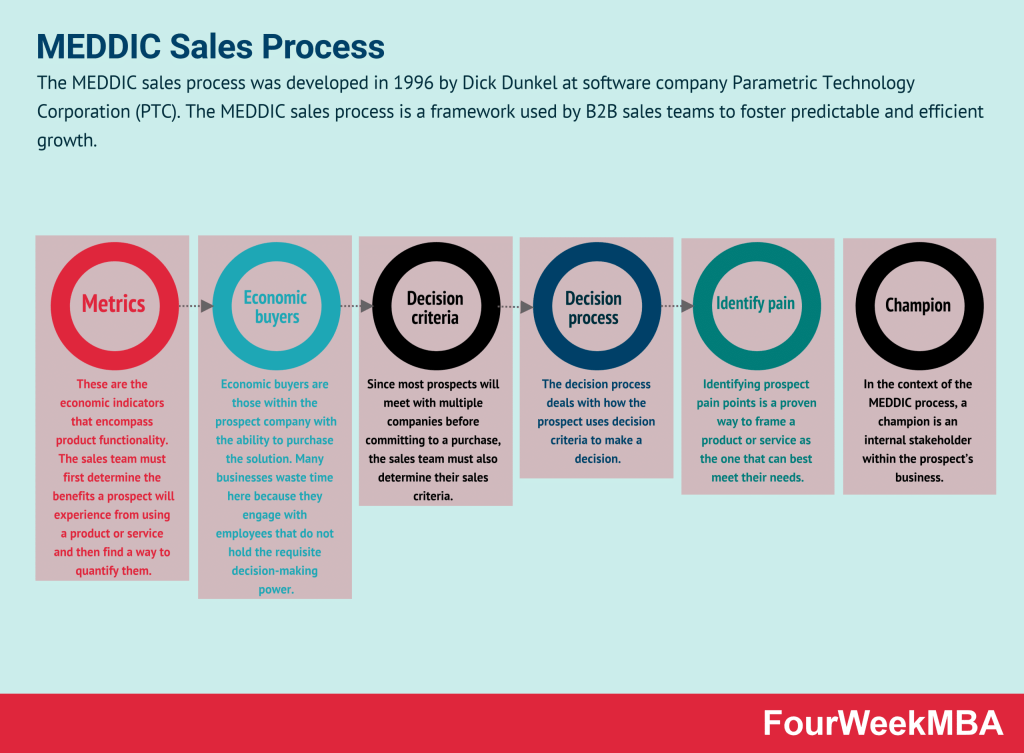Business Development

Sales vs. Marketing

Sales Cycle

RevOps

Revenue Modeling

Customer Experience Map

AIDA Model

Social Selling

CHAMP Methodology

BANT Sales Process

MEDDIC Sales Process

STP Marketing

Sales Funnels vs. Flywheels

Pirate Metrics

Bootstrapping

Virtuous Cycles

Sales Storytelling

Enterprise Sales

Outside Sales

Sales Distribution Framework

Palantir Acquire, Expand, Scale Framework

| Concept | Description | How to Use | When to Use | Benefits |
|---|---|---|---|---|
| Business Development | Strategies and actions for business growth via sales, marketing, and distribution. | Develop a growth plan. | When seeking business expansion. | Increased revenue and market presence. |
| Sales vs. Marketing | Distinguishes between sales and marketing approaches based on product cost and target audience. | Align strategies with product type. | When planning sales and marketing efforts. | Efficient resource allocation. |
| Sales Cycle | Represents the steps taken by sales reps to close deals and sell products/services. | Map out the customer journey. | Throughout the sales process. | Improved sales team efficiency. |
| RevOps (Revenue Operations) | Aligns sales, marketing, and customer success departments by sharing data and tools to maximize revenue potential. | Implement RevOps framework. | To streamline revenue-generating processes. | Increased revenue and collaboration. |
| Revenue Modeling | Develops a financial model for revenue generation within a business model. | Use financial analysis and modeling. | During business planning and analysis. | Improved revenue strategy and sustainability. |
| Customer Experience Map | Visualizes customer interactions with a brand, including touchpoints from marketing to support. | Create a visual map of customer journey. | When improving customer experience. | Enhanced customer understanding and loyalty. |
| AIDA Model | Attention, Interest, Desire, Action model for marketing, outlining the customer’s journey toward a purchase. | Tailor marketing strategies accordingly. | When optimizing marketing campaigns. | Improved customer conversion rates. |
| Social Selling | Building trust and rapport with prospects through social media platforms to enhance the sales cycle. | Engage with prospects on social media. | In B2B and long sales cycles. | More effective and personalized sales. |
| CHAMP Methodology | A modern B2B sales qualification framework focusing on challenges, authority, money, and prioritization. | Implement CHAMP criteria in sales. | In complex B2B sales situations. | Better-qualified leads and sales. |
| BANT Sales Process | Qualification process focusing on Budget, Authority, Need, and Timing for identifying potential buyers. | Use BANT criteria for lead qualification. | For quick prospect assessment. | Efficient sales lead identification. |
| MEDDIC Sales Process | A B2B sales framework that emphasizes Metrics, Economic buyer, Decision criteria, Decision process, Identify pain. | Implement MEDDIC in sales processes. | In complex B2B sales situations. | Improved sales efficiency and predictability. |
| STP Marketing | Segment, Target, Position marketing approach to select valuable segments and tailor marketing strategies. | Identify and target market segments. | When refining marketing strategies. | Increased marketing effectiveness. |
| Sales Funnels vs. Flywheels | Models representing the customer journey (funnel) and building ongoing relationships (flywheels) in sales/marketing. | Choose the appropriate model for the business. | For structuring sales and marketing tactics. | Scalable and repeatable sales processes. |
| Pirate Metrics (AARRR) | A simplified model to understand user paths toward becoming customers and brand referrers. | Analyze metrics at each stage (AARRR). | When assessing user conversion paths. | Effective user acquisition and retention. |
| Bootstrapping | Financing business growth from cash flows without external funding, focusing on customer-driven growth. | Focus on sustainable revenue streams. | During early stages of business growth. | Financial independence and control. |
| Virtuous Cycles | Positive loops driving non-linear growth, often seen in digital platforms, accelerating market capture. | Identify and create virtuous cycles. | When seeking rapid market expansion. | Accelerated growth and market dominance. |
| Sales Storytelling | Utilizing storytelling techniques to highlight product/service benefits and solutions during sales pitches. | Craft compelling stories in sales pitches. | In sales presentations and pitches. | Enhanced engagement and persuasion. |
| Enterprise Sales | Procurement of large contracts with complex decision-making, implementation, and longer sales cycles. | Develop strategies for enterprise sales. | When targeting large-scale clients. | High-value deals and revenue. |
| Outside Sales | Sales conducted in-person with prospects in the field, typically for acquiring larger enterprise customers. | Deploy outside sales teams strategically. | When dealing with complex, large accounts. | Effective acquisition of enterprise clients. |
| Sales Distribution Framework | Reflects the mindset of creating new markets/products rather than incremental improvements. | Apply a zero-to-one approach in business. | When aiming for disruptive innovation. | Potential for groundbreaking success. |
| Palantir Acquire, Expand, Scale Framework | Follows the three phases of Acquire, Expand, and Scale in software services business growth. | Implement phases in enterprise software sales. | For software service providers. | Sustainable growth and profitability. |









